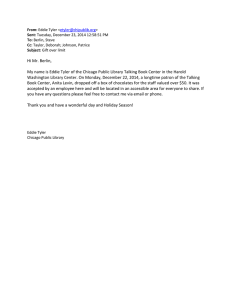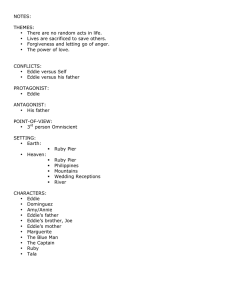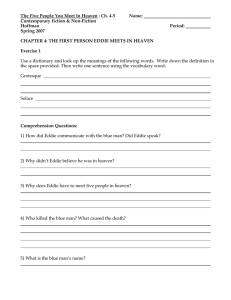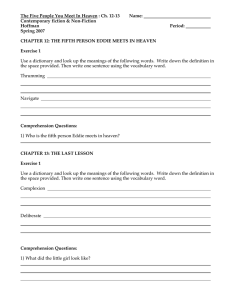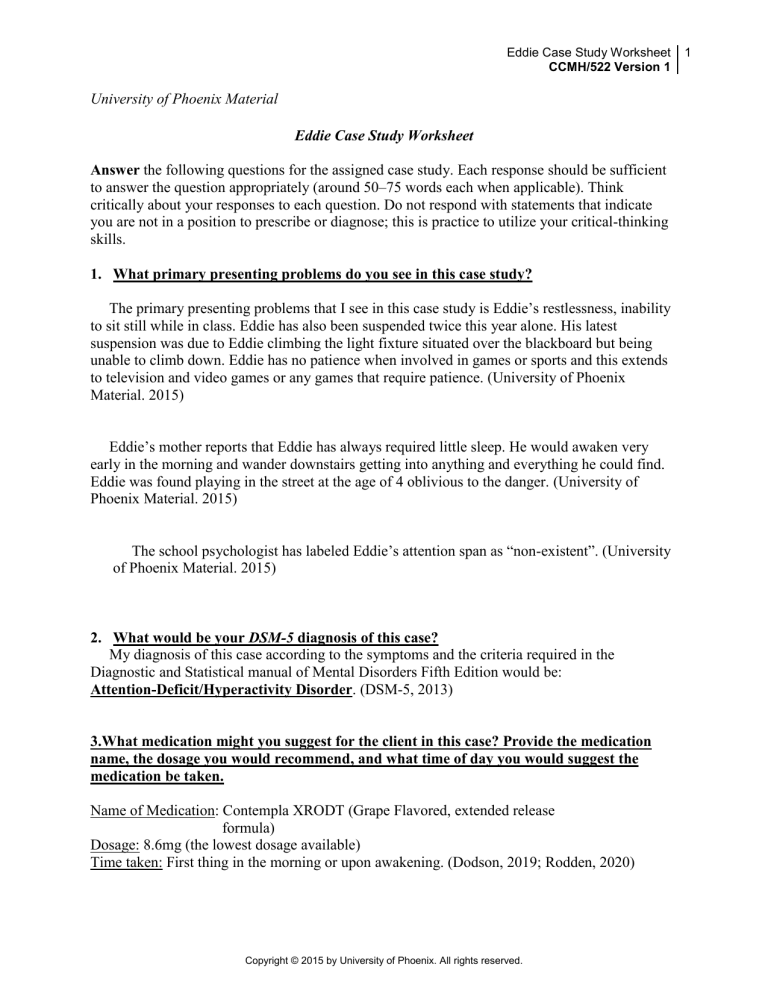
Eddie Case Study Worksheet CCMH/522 Version 1 University of Phoenix Material Eddie Case Study Worksheet Answer the following questions for the assigned case study. Each response should be sufficient to answer the question appropriately (around 50–75 words each when applicable). Think critically about your responses to each question. Do not respond with statements that indicate you are not in a position to prescribe or diagnose; this is practice to utilize your critical-thinking skills. 1. What primary presenting problems do you see in this case study? The primary presenting problems that I see in this case study is Eddie’s restlessness, inability to sit still while in class. Eddie has also been suspended twice this year alone. His latest suspension was due to Eddie climbing the light fixture situated over the blackboard but being unable to climb down. Eddie has no patience when involved in games or sports and this extends to television and video games or any games that require patience. (University of Phoenix Material. 2015) Eddie’s mother reports that Eddie has always required little sleep. He would awaken very early in the morning and wander downstairs getting into anything and everything he could find. Eddie was found playing in the street at the age of 4 oblivious to the danger. (University of Phoenix Material. 2015) The school psychologist has labeled Eddie’s attention span as “non-existent”. (University of Phoenix Material. 2015) 2. What would be your DSM-5 diagnosis of this case? My diagnosis of this case according to the symptoms and the criteria required in the Diagnostic and Statistical manual of Mental Disorders Fifth Edition would be: Attention-Deficit/Hyperactivity Disorder. (DSM-5, 2013) 3.What medication might you suggest for the client in this case? Provide the medication name, the dosage you would recommend, and what time of day you would suggest the medication be taken. Name of Medication: Contempla XRODT (Grape Flavored, extended release formula) Dosage: 8.6mg (the lowest dosage available) Time taken: First thing in the morning or upon awakening. (Dodson, 2019; Rodden, 2020) Copyright © 2015 by University of Phoenix. All rights reserved. 1 Eddie Case Study Worksheet CCMH/522 Version 1 4.Identify the primary side effects of concern you would address with this client. Since Eddie is a minor, I would also include his parents and/or caregivers in this discussion. First of all, most individuals do not experience any side effects from Contempla XRODT. (Rodden, 2020) That having been said, the listed side effects are: A. MOST COMMON SIDE EFFECTS: 1. A decrease in appetite 2. Dry mouth 3. A disruption/interruption in sleep patterns 4. Dizziness 5. Stomach aches 6. An increase in perspiration (sweating) 7. Headache 8. Nausea 9. Loss in weight 10. Irritability (especially when medication is wearing off) (Rodden, 2020) B SERIOUS SIDE EFFECTS: 1. Slowing of growth in children 2. Priapism (an erection that doesn’t subside) 3. Changes in eyesight or blurred vision (Rodden, 2020) 5.Would you recommend hospitalizing the client in this case? Explain the rationale behind your decision. I see no reason to hospitalize Eddie at this time. He is not having hallucinations or delusions. He is not planning on hurting himself or others. I believe that he should see a General Practitioner for a thorough check up and a diagnosis of ADHD so that he can be prescribed any necessary medication. 6.What alternative treatments might you recommend for this client to address the reported problems? What alternative medications might you suggest? A.Some alternative treatments used for Attention-Deficit /Hyperactivity Disorder are: 1. Dietary management/change in diet 2. Supplements of vitamins and/or trace elements/minerals 3. Homeopathy (belief that the body can cure itself) 4. Hypnotherapy 5. Biofeedback 6. Vision therapy Copyright © 2015 by University of Phoenix. All rights reserved. 2 Eddie Case Study Worksheet CCMH/522 Version 1 7. Oculovestibular treatment, or sound training (Tomatis method) NOTE: at this point in time, there is no evidence to support that these alternative treatments actually are of use to individuals with ADHD. (PubMed.gov, Baumgaertel, 2021) B.Some alternative methods I would suggest as possibly being helpful for Eddie are: 1. Hydrotherapy 2. Art Therapy 3. Music Therapy 4. Exercise (Yoga, running, etc.) 5. Breathing relaxation exercises (Mayo Clinic, 2021) 7. What are some special considerations or ethical concerns that you may encounter when using pharmacological treatment with children and older adults? A. Children 1. Parents/caregivers opposed to medication for the child. 2. Stigma from other kids if they find out about the taking of medication and why it is being taken. 3. Possible harmful side effects 4. Outright rebellion against medication 5. Previous or ongoing illnesses 6. Family religious or cultural taboos 7. Allergies 8. No evidence of testing or studies on whether the drug does work as stated. 9. Informed consent (Kaur, et al. 2013) B. Senior Citizens 1. Unable to handle normal doses 2. More or stronger side effects 3. Forgetting to take the medication. 4. Stigma from family/friends 5. Prescribing dosage according to weight/body fat 6. Family vehemently opposed to the medication for the individual 7. Overdose 8. Mixing medications 9. Informed consent (Rochon, 2020) Copyright © 2015 by University of Phoenix. All rights reserved. 3


